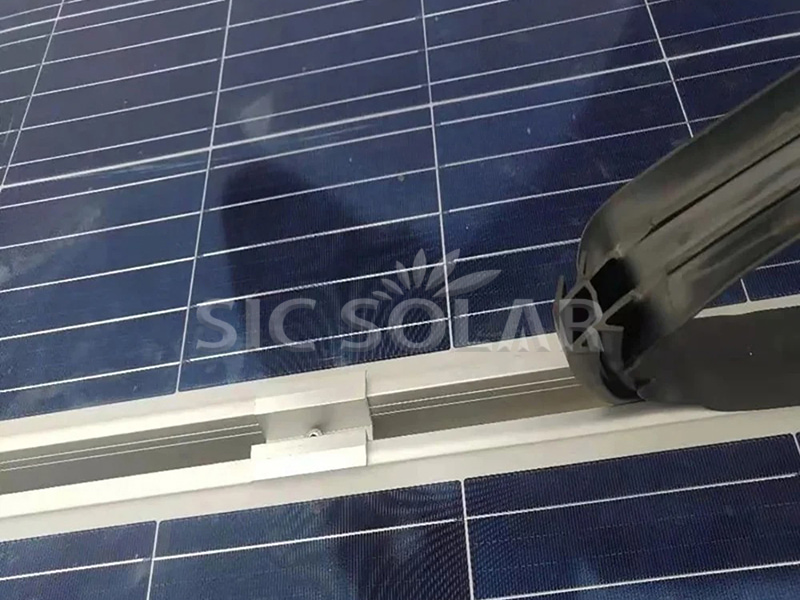
¿Qué estás buscando?
Al observar un conjunto de paneles solares, ya sea en un tejado o sobre el suelo, es posible que note pequeños espacios o huecos entre los módulos individuales. Estos huecos no son accidentales; son parte esencial de cualquier instalación solar bien diseñada. Sin embargo, en algunos casos, especialmente cuando la estética o consideraciones ambientales específicas son prioritarias, rellenar los huecos entre los paneles solares se vuelve importante. Entonces, ¿cómo se gestionan estos huecos y qué soluciones existen?
¿Por qué existen las brechas en primer lugar?
Los paneles solares necesitan un poco de espacio. Los pequeños espacios entre los módulos, normalmente de unos pocos centímetros de ancho, cumplen varias funciones:
Expansión térmica: Los paneles y componentes de estantería se expanden y contraen ligeramente con los cambios de temperatura. Los espacios permiten este movimiento, evitando tensiones y posibles grietas.
Ventilación: El espacio ayuda a que el aire fluya alrededor y debajo de los paneles, lo que favorece la refrigeración y mejora el rendimiento de los paneles.
Acceso de mantenimiento: Incluso los espacios estrechos pueden facilitar la instalación o el ajuste de herramientas o soportes de montaje sin quitar los paneles vecinos.
A los fabricantes les gusta SIC Solar , conocidos por sus sistemas de montaje fotovoltaico de alta calidad, diseñan estanterías y abrazaderas que mantienen estos espacios críticos al tiempo que garantizan que el conjunto permanezca estable y seguro.
Cuándo y por qué rellenar los huecos
A pesar de sus beneficios, existen circunstancias específicas en las que es deseable rellenar los huecos entre los paneles:
Fines estéticos: En sistemas fotovoltaicos integrados en edificios (BIPV) o techos residenciales, puede preferirse una superficie negra elegante y continua por su atractivo visual.
Impermeabilización: En regiones con alta precipitación o climas nevados, las grietas pueden permitir que el agua o la nieve se filtren hacia la estructura subyacente. Rellenarlas puede prevenir fugas o acumulaciones de hielo.
Prevención de plagas: Los huecos abiertos pueden atraer aves o roedores, que anidan debajo de los paneles, especialmente en los tejados. La malla o las tiras de relleno pueden actuar como barrera.
Soluciones para rellenar huecos entre paneles solares
Existen varias técnicas y materiales disponibles para solucionar los huecos no deseados en los paneles:
Faldones o adornos entre módulos
Algunos fabricantes ofrecen kits de molduras o faldones que se colocan entre los paneles o a lo largo de su borde, lo que proporciona una apariencia limpia y uniforme. Estos accesorios suelen instalarse junto a los módulos durante el montaje del rack y no interfieren con la ventilación del sistema.
Cintas de sellado o burletes
Para instalaciones que requieren protección adicional contra la entrada de agua, se pueden aplicar cintas de sellado de goma o espuma resistentes a los rayos UV entre los módulos. Estos materiales son flexibles y comprimibles, lo que permite el movimiento térmico y bloquea la humedad.

Cubiertas de aluminio para huecos
Los perfiles ligeros de aluminio, a veces anodizados en negro por motivos estéticos, se pueden fijar con clips o fijaciones entre las filas o columnas de paneles. Se utilizan a menudo en sistemas solares para fachadas o cocheras, donde el diseño es tan importante como la funcionalidad.
SIC Solar
proporciona dichos accesorios como parte de sus kits de montaje, adaptados a diferentes tamaños de módulos y tipos de instalación.
Barreras contra plagas y relleno de malla
Para evitar la anidación de fauna silvestre, se pueden añadir tiras de malla de acero inoxidable o plástico entre los módulos o alrededor del perímetro del sistema. Estas suelen ajustarse a la medida del sistema de estanterías y no interfieren con el rendimiento ni el drenaje.
Diseños de paneles integrados
Algunos paneles solares modernos están diseñados para entrelazarse o superponerse ligeramente, eliminando por completo las separaciones tradicionales. Estos se observan a menudo en tejas solares o sistemas BIPV completamente negros, donde el propio panel actúa como generador de energía y material de construcción.
Consideraciones antes de rellenar huecos
Antes de decidir rellenar los huecos de los paneles, es importante evaluar las ventajas y desventajas. Un sellado excesivo puede reducir el flujo de aire y provocar un ligero sobrecalentamiento de los paneles en climas cálidos. Los materiales añadidos también deben ser resistentes a los rayos UV y a la intemperie para garantizar la durabilidad del sistema. Además, debe comprobarse la compatibilidad con el sistema de montaje existente, especialmente al utilizar componentes de proveedores de confianza como
SIC Solar
, cuyos sistemas están diseñados con tolerancias precisas para una estabilidad a largo plazo.